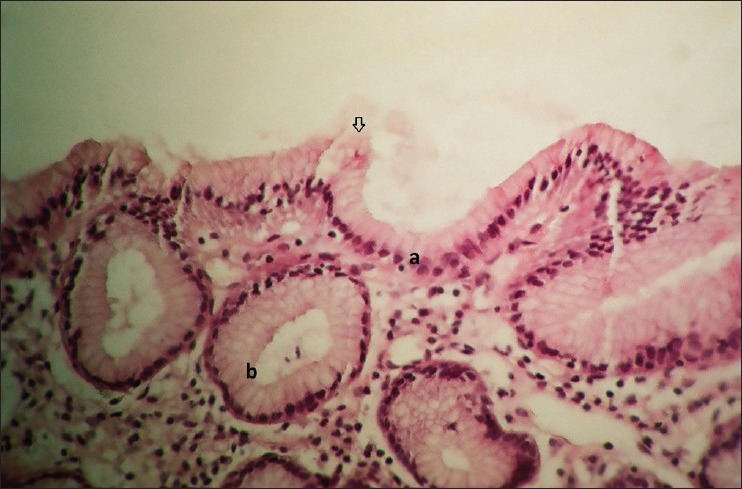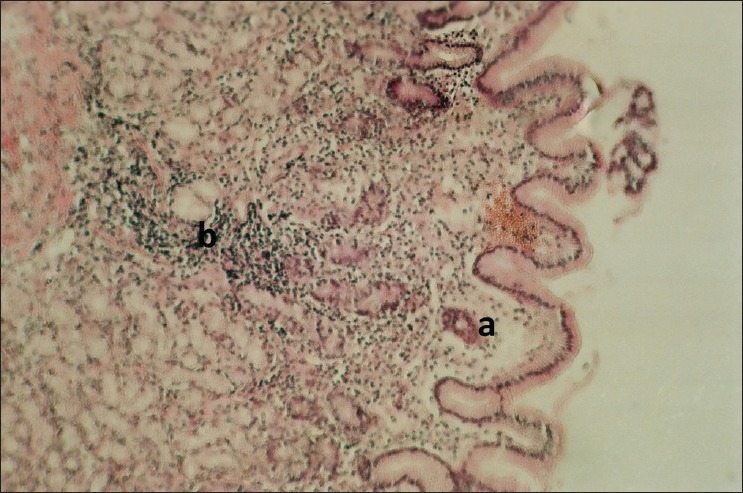Sir,
Peptic ulcer is an inflammation in the lining of the stomach or duodenum with Helicobacter pylori being the major cause.[1] The standard therapeutic measure is to eradicate the bacterial infection among them. One week “triple therapy” is recommended as the treatment of choice, consisting of a proton pump inhibitor such as omeprazole and the antibiotics of clarithromycin, and amoxicillin. Initial treatment failure due to resistance requires alternative strategies, like a quadruple therapy, which adds a bismuth colloid, e.g., bismuth subsalicylate.[2] Herbal medicine has been opened its way in therapy of gastric ulcer,[3] among them, licorice (liquorice or sweet wood) was shown to have anti H. pylori effects[4] derived from the roots and stolons of Glycyrrhiza species.[5] In modern medicine, licorice extract has been used for pepticulcer and as an alternative to bismuth that has a protective role against acid and pepsin secretions by covering the site of lesion and promoting the mucous secretion.[6] This study aims to compare the quadruple therapy of amoxicillin, metronidazole, omeprazole, and bismuth sub nitrate with the same treatment while licorice is replaced by the bismuth sub nitrate in peptic ulcer patients.
In a double-blind study, 40 patients with peptic ulcer referring to Gastroenterohepatology Research Center of Shiraz University of Medical Sciences were divided into two equal groups. All patients had previously undergone endoscopic examination to confirm their peptic ulcer histologically and the presence of bacteria was verified by urease breath test. The first group received amoxicillin (500 mg, 3 times/day after diet for 15 days), metronidazole (250 mg, 4 times/day after diet for 15 days), omeprazole (20 mg, 2 times/day ½ h before the diet for 30 days) and bismuth sub nitrate (500 mg, 3 times/day ½ h before the diet for 30 days). In Group 2, the regimen was identical, but licorice was replaced for bismuth sub nitrate (250 mg, 3 times/day ½ h before the diet for 30 days). After 1 month of therapy, all patients underwent endoscopy again providing a biopsy for histological study to determine the peptic ulcer healing rate and urease breath test to denote the extent of H. pylori eradication. Moreover, pain relief was also evaluated. The study was approved by the university Ethics Committee and an informed consent was provided from each participant.
In Group 1, 15 were male and 5 were female and in Group 2, 11 patients were male and 9 were female. The healing of peptic ulcer was visible in 95% of Group 1 and 70% of Group 2. Pathologically, in Group 1, the eradicative effect of licorice against H. pylori was 70% in comparison to Group 2 (45%). These figures based on the urease breath test results were 55% and 40% respectively. In 80% of Group 1, a reduction in pain was noticed when compared with Group 2 (70%). In Group 1, 40% and in Group 2, 30% of patients reported a previous family history of peptic ulcer.
Figure 1 shows an ulcer in the antrum of patients before treatment and the presence of inflammatory cells (a) (H and E, ×30). In Figure 2, the arrow denotes to the H. pylori infection (a shows the epithelial cells and b the gastric gland; H and E, ×200). Figure 3 demonstrates the absence of H. pylori infection and the presence of inflammatory cells in the tissue and the healing effect of licorice(indicates epithelial cells and b the necrosis region; H and E, ×100).
Figure 1.

Presence of ulcer in the antrum before treatment
Figure 2.

(a) Epithelial cells, (b) gastric gland. Arrow: Helicobacter pylori (H and E, ×200)
Figure 3.

Absence of Helicobacter pylori regions. (a) Epithelial cells, (b) necrosis (H and E, ×100)
There are some studies to confirm our results, but the positive effect of licorice in peptic ulcers was more prominent.[7,8] Fukai et al. reported weak healing effects for licorice in peptic ulcer too.[9]
Our findings showed that licorice could be suggested as a replacement in treatment for quadruple therapy when this regimen is not available while licorice has a low-cost, highly tolerable and with minimal side-effects.
ACKNOWLEDGMENT
We thank Shiraz University of Medical Sciences for financial support and appreciate the cooperation of Gastroenterohepatology Research Center.
REFERENCES
- 1.Farshad S, Japoni A, Alborzi A. Helicobacter pylori and extra digestive disorders in the past 10 years. Iran Red Crescent Med J. 2009;11:123–32. [Google Scholar]
- 2.Graham DY, Shiotani A. New concepts of resistance in the treatment of Helicobacter pyloriinfections. Nat Clin Pract Gastroenterol Hepatol. 2008;5:321–1. doi: 10.1038/ncpgasthep1138. [DOI] [PMC free article] [PubMed] [Google Scholar]
- 3.Mehrabani D, Rezaee A, Azarpira N, Fattahi MR, Amini M, Tanideh N, et al. The healing effects of Teucrium polium in the repair of indomethacin-induced gastric ulcer in rats. Saudi Med J. 2009;30:494–9. [PubMed] [Google Scholar]
- 4.Nariman F, Eftekhar F, Habibi Z, Massarrat S, Malekzadeh R. Antibacterial activity of twenty Iranian plant extracts against clinical isolates of Helicobacter pylori. Iran J Basic Med Sci. 2009;12:105–11. [Google Scholar]
- 5.Nomura1 T, Fukai T, Akiyama T. Chemistry of phenolic compounds of licorice (Glycyrrhizaspecies) and their estrogenic and cytotoxic activities. Pure Appl Chem. 2002;74:1199–206. [Google Scholar]
- 6.Asl MN, Hosseinzadeh H. Review of pharmacological effects of Glycyrrhizasp. and its bioactive compounds. Phytother Res. 2008;22:709–24. doi: 10.1002/ptr.2362. [DOI] [PMC free article] [PubMed] [Google Scholar]
- 7.Khayyal MT, Seif-El-Nasr M, El-Ghazaly MA, Okpanyi SN, Kelber O, Weiser D. Mechanisms involved in the gastro-protective effect of STW 5 (Iberogast) and its components against ulcers and rebound acidity. Phytomedicine. 2006;13(Suppl 5):56–6. doi: 10.1016/j.phymed.2006.03.019. [DOI] [PubMed] [Google Scholar]
- 8.Mukherjee M, Bhaskaran N, Srinath R, Shivaprasad HN, Allan JJ, Shekhar D, et al. Anti-ulcer and antioxidant activity of GutGard. Indian J Exp Biol. 2010;48:269–74. [PubMed] [Google Scholar]
- 9.Fukai T, Marumo A, Kaitou K, Kanda T, Terada S, Nomura T. Anti-Helicobacter pyloriflavonoids from licorice extract. Life Sci. 2002;71:1449–63. doi: 10.1016/s0024-3205(02)01864-7. [DOI] [PubMed] [Google Scholar]


